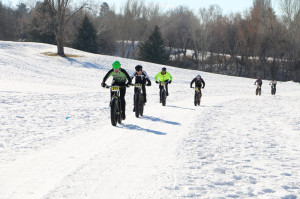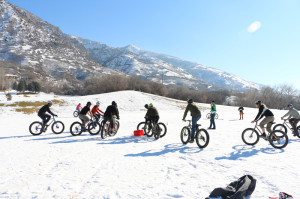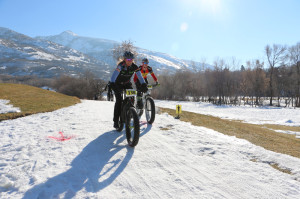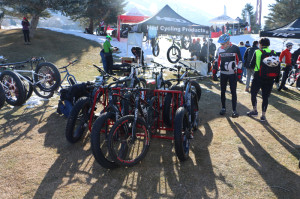
By Jared Eborn
Ogden – Fat Bikes – those odd-looking hulks roaming the mountains and snow-covered roads with increasing frequency – aren’t going away.
Not that anyone wants that to happen, technically, but the fast-growing trend of riding ultra-wide-wheeled bikes where few cyclists have ever gone is more than just a curiosity.
And with more fat bikes hitting the trails each year – 2013 saw more than $10 million in sales – there are issues far greater than simply keeping supply up with demand.
Trail access and land stewardship – issues more than familiar to the mountain bike crowd that has the highest fat bike use – is foremost in the mind of manufacturers, bike shops and riders. After all, making selling and owning bikes isn’t of much use if the bikes themselves are frowned upon by those people who groom and maintain winter trails.

That’s precisely why Quality Bike Products and a handful of other sponsors invited representatives from the U.S. Forest Service, BLM and parks services to the 2014 Global Fat Bike Summit held in Ogden in January.
IMBA director Mike Van Abel was among those in attendance at the meeting and addressed the crowd of more than 100.
“Fat bikes have the potential of creating a sizable user group, too, and we need to talk about how to head off those potential user conflicts,” Van Abel said.
National Parks currently outlaw fat bikes during winter months, even on groomed roads turned snowmobile and snow coach pathways. Many state parks, forests and other trail systems likewise have yet to post a welcome sign to the winter sports newcomers.
The meeting in Ogden was designed to work on breaking down some of those barriers – not through ramrodding their way onto trials, but through dialogue and understanding.
Some user groups, especially Nordic skiers, fear the impact fat bikes might have on their treasured groomed trails – especially if there is misunderstanding on what the difference between a traditional mountain bike and a fat bike is. With 3-5 inch wide tires, fat bikes float along the surface of most trails and don’t sink into (and destroy) the groomed surfaces and tracks needed by skiers.

Other user groups, notably snowmobilers, are less concerned because fat bikes threaten little impact that a snowmobile can’t handle.
“We’re not advocating for unilateral access for fat bikes versus Nordic skiers, but this is a new revenue source for them,” Van Abel explained. With proper discussion and trail sharing, the emerging fat bike market can become an added source of funding or trail building and management.
Going rogue, Van Abel said, and just riding whenever and wherever a fat cyclist wants will cause far more problems with trail access than it will solve.
Utah has become a hub of fat biking with a handful of brands and parts makers setting up shop in the state. A grassroots fat bike race series has been held with a couple dozen participants each week.
The Global Fat Bike Summit – held with sparse attendance in the Island Park/West Yellowstone area previously – enjoyed its largest turnout ever and also held a race at the Mount Ogden Golf Course and saw nearly 100 participants.
Fat Bike Race
Alaska’s James Stull took home top honors in the men’s elite race, covering the four lap course in 46 minutes and 10 seconds. Provo’s Geoffrey Montague took second place, just one second back, while Ogden’s Brent Pontius rounded out the podium just 26 seconds off the pace.

Ketchum, Idaho’s Tory Canfield was the fastest women in the elite field, completing her four lap race in 1:06:40.
The men’s novice race hit the course for three laps and Bozeman, Montana’s Jacob Wahry won with a time of 41:09. Providence, Utah’s Brian Jensen was second with Crested Butte, Colorado’s Sean Riley pipping Ammon, Idaho’s Brian Hobbs for third.
Sandy’s Gina Rau won the women’s novice race with a time of 47:21. Beth Shaner (Crested Butte) and Judy Allen (Salt Lake City) completed the women’s novice podium.

